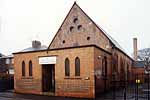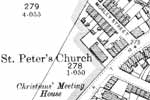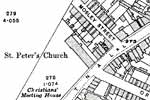 Hucknall Hucknall
St Peter
History
The beginnings of the church started with a mission set up in 1889 by Charles Blanchard, in the newly-created hamlet of Hazel Grove. Initially services were held in a cottage, with forty-two people attending, but with more on the register, and a Sunday School was established. The rapid growth of the mission meant that the room soon became too small for the congregation, and so Blanchard appealed for funds and help from parishioners for a new church.
He thought ‘perhaps of an iron one’ which might cost about £400. By December 1891 fundraising was in full swing, with parishioners organising events such as magic lantern shows. It was also announced in December ‘that a very excellent site on Watnall Road had been given by the Misses Jackson of Broomhill House for the new mission church’. The site was a field. The Duke of Portland promised £100, and by January 1892 £370 had been pledged in total, which meant that architects could be engaged to prepare plans for the building.
Events began to move very quickly. On 25 February a meeting accepted James Whyatt’s tender of £535 to build the new church. In April there was the news that Her Grace the Duchess of Portland had consented to lay the foundation stone on St. Mark’s Day, 25 April. She was expected to arrive at the Midland Station at 2.20 pm and be driven to the Parish Church for a short service beforehand. The day was to be an exciting one for Hucknall. The decoration committee were up early fixing arches, festoons and banners and the spontaneous actions of residents who set up ducal flags, streamers and arches made the streets look very pretty. The train was late due to an accident, but the Duke’s carriage with four black horses and postilions stood waiting to take the head of the procession to St Mary’s Church. After the service the procession reformed behind the Hucknall Temperance Prize Band and made their way through cheering crowds up to the site of the new church. Mr J Widdowson, church warden, presented Her Grace with a handsome silver trowel which bore the inscription ‘This trowel was presented to Her Grace the Duchess of Portland on the occasion of her laying the foundation stone of St. Peter’s Church, Hucknall Torkard, April 25th 1892’. The Duchess said ‘I declare this foundation stone duly laid in the name of the Father, Son, and the Holy Ghost’. Their Graces were then taken to the Public Hall where a tea had been provided.
Obviously the contractors and builders had been working hard since it was reported that ‘on the fourth August, if God will, the Lord Bishop for the Diocese will open the mission church of St. Peter for divine service. It will be a happy event’.
The church was duly opened by the Bishop of Southwell. After all the bills were paid the treasurer recorded that £150 was still owing. Newly opened at the time of Bishop Ridding’s visitation in 1892, St Peter’s Mission was recorded as one of the ‘eighteen new mission churches in Nottingham’. It was brick-built and situated about half a mile from the parish church of St Mary Magdalene.
The Reverend Charles Blanchard was the first curate, followed by the Reverend A Clarke who had been assisting the vicar of Hucknall St Mary Magdalene. Wright’s Directory of Nottingham in 1910-11 reported that the church consisted of a chancel and nave, and could hold 250 people. Local historian Beardsmore in 1909 reported that the vestry and schoolroom had also been added. It appears that very few structural or decorative changes were made to the church in the early years, with the exception of eleven large scripture paintings which were added in December 1892. They were from the Religious Tract Society and were mounted on canvas, varnished and framed by Whyatt and Brand. The church also purchased and erected a new organ in 1896.
After its opening, the Christmas of 1892 was a chance to welcome more of the community into the newly built church. A light screen was erected to divide the sanctuary from the rest of the building, enabling the hall to be used for a variety of meetings and social gatherings. A ladies committee was also formed for the purpose of providing tea and entertainment as St Peter’s began to take shape as a focal point for the community. In 1894-95, Wright’s Directory reported that services were being held on a Sunday at 11am and 6.30pm. However, it appears that the church remained relatively small, especially in comparison to Hucknall St Mary’s or St John’s.
 The church site in 1899 The church site in 1899 |
 The church site in 1914 The church site in 1914 |
At the onset of the First World War in 1914 there were 194 members in St Peter’s; but by 1918 this had dropped to 154. The small size of the church could be seen to be a lack of any enlargement within the church building. The church was recorded by various directories such as Wright’s and Kelly’s which do not mention any structural changes in the church building since its opening in 1892. However, Ordnance Survey maps surveyed in 1899 and 1914 clearly show that, between these dates, the church was considerably extended at the rear and at the front. This presumably consisted of the vestry and schoolroom reported by Beardsmore in 1909 and the projecting porch at the front.
During the First World War the curate-in-charge, the Rev. P. F. Robinson was, according to the Nottingham Journal, 'so eager to be of service during the war period that in addition to his ecclesiastical duties he worked as a miner at Linby pit, and also served for one year as a chaplain in France'.
The Hucknall Dispatch on 4 August 1938 reported ‘There are now prospects of a fairly speedy launching of the scene to provide a church at Westville. The Church Council are now in a position to purchase a site which can be used as a centre for spiritual and social work. St. Peter’s district members will be called upon to tackle the work. The Rev. J H Gibson intimates that the centre of the work now at St Peter’s will eventually have to move out to Westville and for this reason it is important that there should be close connection between the two from the outset.’ It is not clear whether work on Westville stopped because of the war, to be eventually taken to the site on Ruffs Estate, or whether this was where St. Paul’s makes its appearance.
In 1962 St Peter’s closed, although the reason is uncertain. The area was being redeveloped, with most of the old cottages demolished and new council housing being built. People were moving away and the congregation dwindled, perhaps because they preferred to attend the already existing Wesleyan, Baptist, and Primitive Methodist churches which were on the same road. Also a new Baptist church had been opened on Seymour Road, Hucknall, about a mile to the west in 1959. What is known, however, is that the statue of St Peter found a new home in St Mathias in Sneinton, bringing a close to the church at St Peter’s on Watnall Road. St Peter’s had by 1967 become an Old People's Social Centre, and later became the Nottingham City Outreach Church. In 2014 it was used as the Watnall Road Community Centre.
| 


 The church site in 1899
The church site in 1899 The church site in 1914
The church site in 1914





